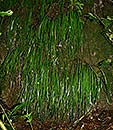Vittaria guineensis Desv. var. orientalis Hieron.
Synonyms |
Vittaria loricea sensu Peter, non Fée |
|---|---|
Common name |
|
Description |
Rhizome fairly thick, shortly creeping; rhizome scales narrowly lanceolate, with or without a short hair-tip, dark brown, c. 3.5 mm long, margins ciliate. Fronds simple, spaced 3-10 mm apart, coriaceous, arching or pendulous; stipe castaneous to black, up to 3 cm long. Lamina up to 35 × 0.6 cm, narrowly elliptic to linear, apex tapering to a point, base tapering, midrib obvious below but not raised, veins obscure. Sori in two submarginal grooves up to 0.6 mm from the margin; indusium continuous, along both sides of the soral line. |
Notes | Can be distinguished from other species by a combination of having a black stipe base, a midrib that is faintly visible but not raised below and rhizome scales that are less than 4 mm long and ciliate. |
Derivation | guineensis: from Guinea (West Africa), orientalis: implying that the variety's distribution occurs futher east. |
Habitat | Epiphyte or lithophyte, shade, moist evergreen forest. |
Distribution worldwide | |
Distribution in Africa |
Burundi, Cameroon, Congo, Dem. Republic of Congo, Ethiopia, Kenya, Liberia, Malawi, Mozambique, Rwanda, Tanzania , Togo, Uganda, Zambia, Zimbabwe. |
Growth form |
Epiphytic, lithophytic. |
Literature |
|


